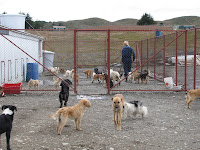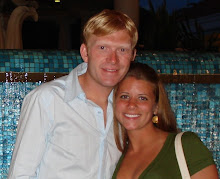It comes as no surprise that Patagonia is a draw to many travelers for various different reasons. There are loads of Americans, Europeans, Israelis and Australians down here. I like to call Patagonia the place where people come with too much money and too little vacation time. The prices for tourists activities, transportation, hotels, etc. reflect this. We have actually run into many of the same people at every site as we move around the Patagonia circuit, decked out in high-end goretex and wandering around town carrying hiking poles (why people feel the need to carry these everywhere is beyond me). It makes for an interesting dynamic in these small towns, but also makes you feel like you are on some sort of big tour as you pile in and out of the same buses.
The sights here are extraordinary though, and it is easy to see why so many people have chosen to come, us included. After resting up in Puerto Natales for a night after our big hike, we headed back over the Argentine border to the small town of El Calafate. Calafate is a tourist town to it’s bones and there is only one reason to go there, to see the dynamic Perito Moreno Glacier located 80 km away in Parque National Los Glaciers. We had planned to spend 2 nights in Calafate but after a sleepless night in a creaky dorm room, we opted to head out early to spend the day at the glacier and then continue to our next destination via a late afternoon bus. It was quite pricey to get into the national park (they raise the fees during high season for foreigners) and with the rain coming in and out we hoped the glacier would be worth it. It did not disappoint.
Perito Moreno Glacier measures 30 km long, 5 km wide and up to 60 meters high. It is considered stable in a time when most of the world’s icebergs are receding. What makes it
 more exceptional is that it is actually advancing, up to 2 meters per day, which in turn causes constant calving of icebergs from it’s face down into the blue waters below. The sound of ice falling and hitting the water is exhilarating, like a massive clap of thunder. We wandered the walkways for a few hours and spent a fair amount of time staring intently at the glacier, waiting for the next giant piece to peal off. It was a very pleasant way to spend the morning and still allowed us to catch the bus back to town and another bus, 3 hours further north in Argentina to the village of El Chalten.
more exceptional is that it is actually advancing, up to 2 meters per day, which in turn causes constant calving of icebergs from it’s face down into the blue waters below. The sound of ice falling and hitting the water is exhilarating, like a massive clap of thunder. We wandered the walkways for a few hours and spent a fair amount of time staring intently at the glacier, waiting for the next giant piece to peal off. It was a very pleasant way to spend the morning and still allowed us to catch the bus back to town and another bus, 3 hours further north in Argentina to the village of El Chalten. Where do I start with El Chalten? It is Argentina’s newest town, founded in 1985 to cement Argentina’s hold on that particular part of the border with Chile. The village swells to 1800 people in the summer tourist season and it virtually shuts down in winter months. Want to claim something as your country? Build a town! Apparently it is working and El Chalten now exists solely on tourism as it sits strategically at the base of the Fitz Roy mountain range.
 It is considered to be a world class climbing destination and people come from all over the world to summit Mt Fitz Roy and Mt. Torre (said to be the most difficult climb in the world, mas or minus). We intended to do some more hiking and camping but the good old Patagonia weather continued to have her way with us. We spent the first 2 nights camped in town, while 50mph winds gusted around us. I have no idea how our tent did not collapse on the spot (we counted no less than a half dozen tents with snapped poles in our campground alone). Our first hike of the area started off well, but an hour and a half into it the rains came and they did not let up. We called it quits, hiked back to our tent, changed clothes and decided that what we needed was a good beer to combat the horrible weather. Luckily for us this tiny town had a small brewery, so off we went and tucked ourselves inside for the night, enjoying a beer, popcorn and a pizza.
It is considered to be a world class climbing destination and people come from all over the world to summit Mt Fitz Roy and Mt. Torre (said to be the most difficult climb in the world, mas or minus). We intended to do some more hiking and camping but the good old Patagonia weather continued to have her way with us. We spent the first 2 nights camped in town, while 50mph winds gusted around us. I have no idea how our tent did not collapse on the spot (we counted no less than a half dozen tents with snapped poles in our campground alone). Our first hike of the area started off well, but an hour and a half into it the rains came and they did not let up. We called it quits, hiked back to our tent, changed clothes and decided that what we needed was a good beer to combat the horrible weather. Luckily for us this tiny town had a small brewery, so off we went and tucked ourselves inside for the night, enjoying a beer, popcorn and a pizza. The next morning we awoke to bluebird skies, very little wind, and no rain in sight. In Patagonia you have to seize good weather opportunities so we packed up our stuff and headed into the
 mountains for one last night of camping. We hiked in 12 km to a campground at the base of Mt. Fitz Roy, enjoying the jagged mountain top peaks of the Fitz Roy range as we did side hikes to multiple lookouts. We slept in the tent for our last time that night and again the weather felt the need to send us off in style. We awoke at 6:30AM hoping to break camp and hike out early, but the rains had come. We sat the next three hours huddled in our small tent waiting for a break to no avail. Finally we folded our cards and packed up our belongings, disassembled our tent in record time and headed on a long 2 hour sprint in the pouring rain back to El Chalten for our final night in town, spent comfortably in a well equipped hostel.
mountains for one last night of camping. We hiked in 12 km to a campground at the base of Mt. Fitz Roy, enjoying the jagged mountain top peaks of the Fitz Roy range as we did side hikes to multiple lookouts. We slept in the tent for our last time that night and again the weather felt the need to send us off in style. We awoke at 6:30AM hoping to break camp and hike out early, but the rains had come. We sat the next three hours huddled in our small tent waiting for a break to no avail. Finally we folded our cards and packed up our belongings, disassembled our tent in record time and headed on a long 2 hour sprint in the pouring rain back to El Chalten for our final night in town, spent comfortably in a well equipped hostel. 
We had one last stop prior to heading on a flight back north, the town of Punta Arenas. Punta Arenas is at the far southern tip of Chile, about as far south as you can go in the world without reaching Antarctica. The city thrives mostly on tourists heading to and from the national parks an is a pleasant enough place for a traveler to stay for a couple days. We caught up on some laundry from our previous days of camping and took advantage of the local supermarket and hostel kitchen to make some great meals. We had one other stop in town, the local animal shelter whic
 h we had read about online. Punta Arenas has a SERIOUS dog problem; a city of 140,000 people and 20,000 stray dogs. Can you imagine if there was one stray dog for every 7 people in your neighborhood? We hopped a local shared taxi to the edge of town and hiked up a gravel road to the shelter. We were welcomed by the two full time workers who showed us around and got some humor out of our broken Spanish. They gave Chad some coveralls and assigned him to poop patrol (it is amazing how much ‘caca’ 87 dogs can produce in a day) and I took care of some much needed dog petting duties. It was truly uplifting to see the service the shelter was providing for these deprived animals and inspiring that it was all done on such a small budget (local and federal governments provide no money toward animal control in Chile). We made a donation, thanked the staff and wished them the best as they are fighting an uphill battle.
h we had read about online. Punta Arenas has a SERIOUS dog problem; a city of 140,000 people and 20,000 stray dogs. Can you imagine if there was one stray dog for every 7 people in your neighborhood? We hopped a local shared taxi to the edge of town and hiked up a gravel road to the shelter. We were welcomed by the two full time workers who showed us around and got some humor out of our broken Spanish. They gave Chad some coveralls and assigned him to poop patrol (it is amazing how much ‘caca’ 87 dogs can produce in a day) and I took care of some much needed dog petting duties. It was truly uplifting to see the service the shelter was providing for these deprived animals and inspiring that it was all done on such a small budget (local and federal governments provide no money toward animal control in Chile). We made a donation, thanked the staff and wished them the best as they are fighting an uphill battle. The following morning we said goodbye to Patagonia. We were able to spend 8/16 nights in the region camping and indulging ourselves in everything the area has to offer. The landscape, people and animals have definitely left their mark on us


No comments:
Post a Comment